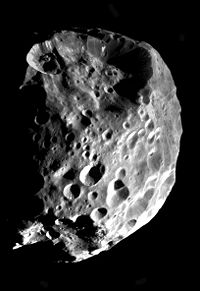
Photo from wikipedia
Abstract Isotopic ratios have long been used to learn about physical processes acting over a wide range of geological environments, and in constraining the origin and/or evolution of planetary bodies.… Click to show full abstract
Abstract Isotopic ratios have long been used to learn about physical processes acting over a wide range of geological environments, and in constraining the origin and/or evolution of planetary bodies. We report the spectroscopic detection of deuterium in Saturn's rings and satellites, and use these measurements to determine the (D/H) ratios in their near-surface regions. Saturn's moons, Phoebe and Iapetus, show a strong signature of CO2 and the 13C component of this molecule is detected and quantified. Large averages of spectra obtained by the Cassini Visual and Infrared Mapping Spectrometer, VIMS, were computed for the rings and icy satellites. The observed intensities of the infrared absorptions in H2O and CO2 and their isotopes were calibrated using laboratory data and radiative transfer models to derive the D/H and 13C/12C ratios. We find that the D/H in Saturn's rings and satellites is close to the Vienna Standard Mean Ocean Water (VSMOW) and bulk Earth (4% lower than VSMOW) value except for Phoebe, which is 8.3 times the VSMOW value. This is the highest value for any Solar-System surface yet measured, and suggests that Phoebe formed from material with a different D/H ratio than the other satellites in the Saturn system. Phoebe's 13C/12C ratio is also unusual: 4.7 times greater than terrestrial, and greater than values measured for the interstellar medium and the galactic center. The high 13C abundance in the CO2 suggests that Phoebe was never warm enough for the large D/H ratio in its surface to have originated by evaporative fractionation of its water ice (e.g., from heating in the inner Solar System before its eventual capture by Saturn). We also report the detection of a probable O-D stretch absorption due to OD in minerals on Phoebe at 3.62 μm. This absorption is not detected on other Saturnian satellites. Stronger signatures of bound water absorptions are found in the dark material of Iapetus and we report a new detection of bound water at 1.9 μm. The position of this absorption matches that seen in spectra of hydrated iron oxides but does not match absorptions seen in spectra of tholins. Despite the strong bound water signature in the Iapetus dark material, no 3.62 μm OD absorption is seen in the spectra, further indicating the high deuterium level on Phoebe is unusual. As such, it is likely that Phoebe originated in a colder part of the outer Solar System, relative to the prevailing temperatures at Saturn's distance from the Sun.
Journal Title: Icarus
Year Published: 2019
Link to full text (if available)
Share on Social Media: Sign Up to like & get
recommendations!